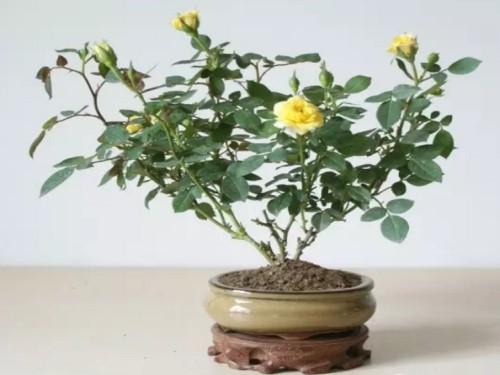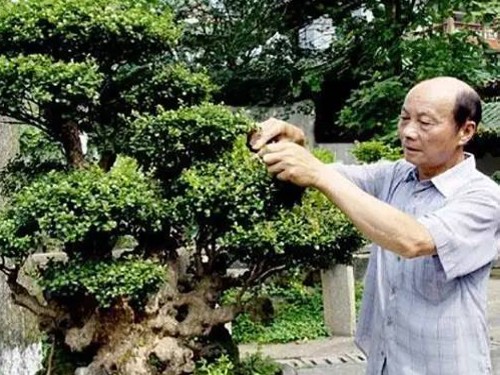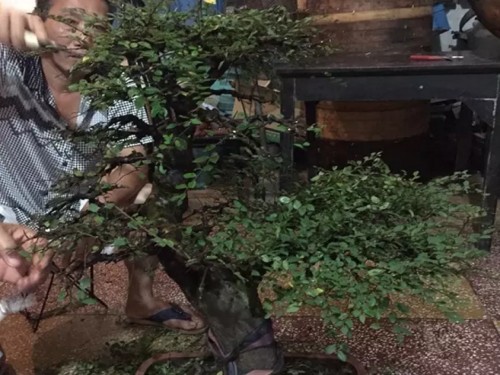How to prune the rose-- the pruning method of rose bonsai
Pruning is one of the important measures of rose management, pruning should be carried out at all stages of growth in order to ensure the blooming of the four seasons. During the growing period, sprouting, budding, and removing residues should be carried out. Sprouting is to wipe out all the buds that have grown too much in spring, except for 2 or 3 buds left on the main branch; budding is to remove the rest of the lateral buds except for the main bud in the middle. The purpose of these two measures is to remove the waste buds and miscellaneous branches, so that nutrients are concentrated to supply the main branches.
The purpose of removing disability is to cut off the flower and its two compound leaves in time when the flower is blooming, in order to prevent several axillary buds near the flower from sprouting weak branches and abnormal florets, which not only wastes nutrients, but also destroys the beauty of the flower.

The dormant period should also be pruned, and the pruning time is around the Spring Festival, mainly to cut off disease and insect branches, withered branches, weak branches, overlapping branches and cross branches from the base of the rose for more than 2 years, and to carry out different degrees of "strong cutting", "medium cutting" or "weak cutting" according to the varieties and characteristics of the rose and its growth. The plants that are too small for potted rose are not suitable for pruning, the plants below 25cm height can be cut off by 1max 3, and those with 25~35cm above 235cm can be cut off by 2max 3.
Only by cutting off the remnant flowers of rose in time can it concentrate nutrients and keep the plant strong and blooming. If the residual flowers are not removed in time, several axillary buds close to the residual flowers will often germinate and form weak branches. These twigs not only consume nutrients but also destroy the plant shape, even if they can bloom, most of them are deformed or poor florets. In addition, except for the flowers that want to harvest seeds, never let the remnant flowers bear seeds.
After the first batch of flowers, the medium branches should be cut in the middle, with 3-4 buds on the branches, 1-2 buds on the weak branches, and 5 buds on the strong branches to restrain the growth properly. The second pruning should be light, only cut the top of the second leaf under the remnant flower, and retain the axillary bud of the second leaf, which has the best advantage in growth and development, and is in the dominant position of the whole plant. Cutting this bud will affect the next florescence, flower quality and plant growth.
The Beginning of Autumn's post-anthesis pruning (the third batch of flowers) was cut in the middle, leaving 3-4 buds per branch. In order to take care of the balance of plant shape, it can also be cut up and down to the last batch of flowering branches. It is necessary to cut off overlapping branches, cross branches, over-dense branches, long branches, etc., so as to facilitate ventilation and light transmission and plant shape symmetry.
At the same time, the post-flowering pruning of rose should be combined with the control of florescence. The rose used on National Day can be pruned 45 days before flowering, leaving 3 or 4 buds in the middle, and then 2 branchlets on each branch. Strengthen fertilizer and water after cutting, pay attention to prevent waterlogging and powdery mildew, flowers bloom one after another in late September.
In addition, pruning can advance or postpone the florescence of Juhua rose. Light cutting of this kind of rose can retain more mature branches and make the plant blossom two weeks earlier, while heavy cutting can make the plant send out strong branches that blossom in autumn and delay the autumn flower by two weeks. Therefore, different pruning can be used to advance or prolong the flowering period of the plant as a whole.
The end of August or the beginning of September is the time for autumn pruning of rose. Pruning at this time coincides with the use of its 45-day growing period to produce beautiful flowers in early October.
Rose needs to be pruned frequently. Especially potted rose, because of limited space, nutrients are not very sufficient, and pruning can reduce unnecessary nutrient consumption, at the same time make the plant type more beautiful, blooming constantly. Otherwise, not only the flowering ability will be weakened, but also the disease resistance will be reduced.
With regard to the relatively strong winter scissors, you must be patient and start pruning after the fallen leaves of the rose, so that the flowers will bloom better in the coming year. Of course, pruning can also be done during the growing period, usually from the end of August to the beginning of September, mainly in order to have flowers in autumn.
In the north, some rose pruning can be very severe, so as to avoid frostbite of branches and sprout as usual the following year. But some areas do not have to do so, generally trimmed off the original height of 1 stroke 3-1 stroke 2 is fine.
For pruning dead branches and diseased branches, if the color of the section is brown or dry, it needs to be pruned further; if you see white flocculent tissue, put down the butcher's knife! The tissue left in this way is healthy.
When pruning the rose, cut off the overly thin branches. They only eat and do not grow (flowers). What is the use of them? The old leaves on the branches may be home to many overwintering germs and pest eggs, so be sure to remove them and clean them up. Otherwise, in the coming year, you will not enjoy the rose flowers, but the pests of a tree.
For shrub roses, the purpose of pruning is to make the center more open for ventilation and light, so the interlaced and thin branches inside should be trimmed, and those growing inward should also be cut off.
Time: 2019-06-10 Click:
- Prev

Daily pruning skills of bonsai
The daily sporadic pruning of bonsai refers to the timely pruning in daily maintenance. Bonsai stumps cultivated by shrubs, their habits into clusters, bonsai modeling can be cultivated into small trees to improve its ornamental effect, so that it is originally a small shrub, but appears in the basin into a towering tree. To the material.
- Next

How to trim tree stump bonsai
Tree stump bonsai is a kind of living work of art that plants old woody plants are planted in a basin, after years of pruning, binding, fertilization and other artistic processing, fine management, so that the trunk is vigorous and powerful, branches and leaves luxuriant. It will not be shaped by the first artificial shape, but will continue to grow and change according to the laws of nature, so
Related
- Fuxing push coffee new agricultural production and marketing class: lack of small-scale processing plants
- Jujube rice field leisure farm deep ploughing Yilan for five years to create a space for organic food and play
- Nongyu Farm-A trial of organic papaya for brave women with advanced technology
- Four points for attention in the prevention and control of diseases and insect pests of edible fungi
- How to add nutrient solution to Edible Fungi
- Is there any good way to control edible fungus mites?
- Open Inoculation Technology of Edible Fungi
- Is there any clever way to use fertilizer for edible fungus in winter?
- What agents are used to kill the pathogens of edible fungi in the mushroom shed?
- Rapid drying of Edible Fungi

